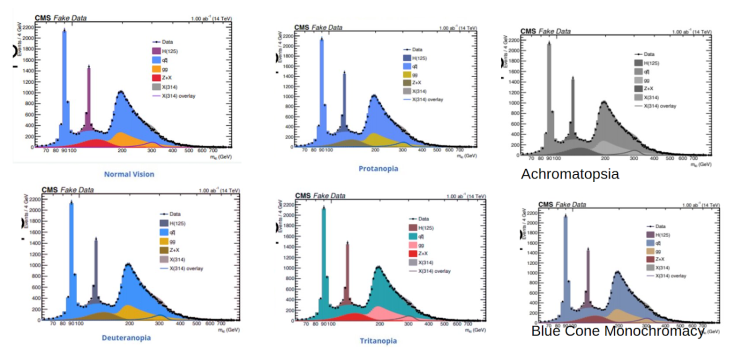
In physics research, results are frequently represented in complex diagrams, and colour is an essential tool to help the reader extract key information. Making sure our colour schemes are friendly to people with colour-vision deficiency (CVD in short, or more traditionally known as “colourbilndness”) is essential. It's not just about personal preference; it's about making sure everyone can access and understand the scientific info we're sharing. That's why the CMS Diversity and Inclusion Office teamed up with CMS Physics Coordination to update our colour guidelines.This initiative not only raises awareness of a critical issue affecting 300 million people worldwide, but it also aims to streamline research processes and foster a more inclusive environment within the CMS community.
Due to the variety of colour vision deficiency that exists (blue-yellow, red-green, or full colour deficiencies), combined with scientific requirements, the task was not easy. After a thorough review of existing guidelines from other experiments and researchers, the process began with a commitment to inclusivity by involving the entire collaboration. In order to gather input from diverse perspectives, a call for colour palette submissions was initiated, inviting every member of the collaboration to contribute their favorite colour combinations. Fifteen 1D colour combinations and five 2D colour maps were submitted by members of the CMS experiment. A collaboration-wide vote was then organized during the CMS week in February to gauge the popularity of the colour combinations and to see which palettes are aesthetically preferred. Submissions were then subjected to rigorous evaluation based on objective criteria designed to ensure their effectiveness in conveying scientific information accurately.
Based on both the objective criteria and the popularity of the votes, new colour palettes were chosen. These selected palettes are seamlessly incorporated into official tools so that they are accessible for all collaborators to use. Since the announcement of the winning colour combination earlier this month, people have already started to adopt these CVD-friendly palettes, together with other guidelines on using different visual cues to further increase the readability. This not only demonstrates the success of the collaborative effort but also underscores its significance in advancing equity and diversity in scientific research. Through this CVD- friendly exercise, the CMS collaboration sets a precedent for an effort of this magnitude for inclusivity and accessibility in physics research, reaffirming its commitment to creating an environment where all researchers can thrive and contribute to scientific progress.

